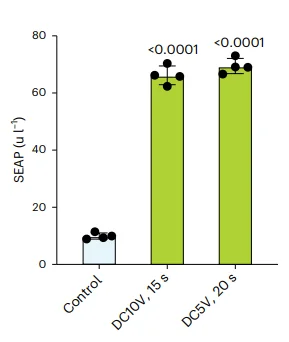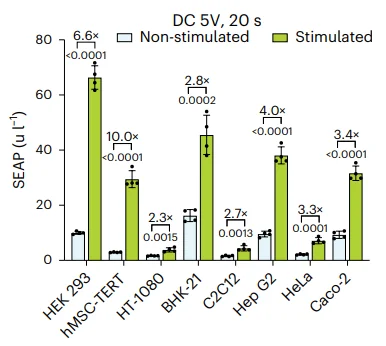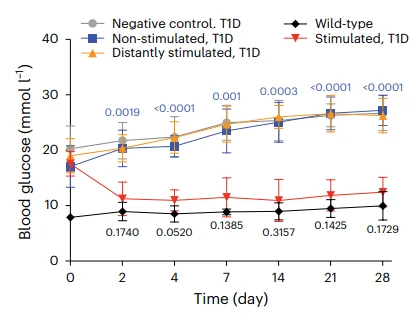A paper published today in Nature Metabolism has described a method of genetically engineering cells to respond to electrical stimuli, allowing for on-demand gene expression.
Finding a better trigger
Despite its futuristic outlook, this line of research is built upon previous work. The idea of an implantable gene switch to command cells in order to deliver valuable compounds into the human body is not new. The authors of this paper cite longstanding work showing that gene switches can be developed to respond to antibiotics [1] or other drugs, and the antibiotic doxycycline is used regularly for this purpose in mouse models. More recently, researchers have worked on cells that control their output based on green light [2], radio waves [3], or heat [4].
However, these mechanisms have their problems. A gene trigger that operates in response to a chemical compound requires that compound to have stable, controllable biological availability [5]. If it relies on any wavelength of electromagnetic radiation, that process may be triggered by mistake or require intense energy to function [3].
Therefore, these researchers decided to focus on developing triggers that respond to electricity itself. While previous work in this area has relied on battery-powered implantable devices that are poorly suited for therapeutic use [6], this team built on a process that naturally exists.
A use for ROS
Reactive oxygen species (ROS) have a well-deserved bad reputation in the world of longevity, as they are associated with mitochondrial dysfunction and age-related deterioration. However, applying low-voltage direct current can induce production of ROS that is well below dangerous levels [6]. While normal cells are not particularly sensitive to such low levels of ROS, these researchers found a way to hypersensitize engineered cells to respond to them. They call their development DC-actuated regulation technology (DART).
In their initial testing apparatus, the researchers engineered cells to produce the glycoprotein SEAP when exposed to electricity. They placed plates of these cells in a medium that was exposed to electrical current between two electrodes. Short-term, low-power DC current was found to have no affect on cell viability. Inducing current for 30 seconds at a time was harmful, but the researchers ascribe this fact to gas and pH changes occurring at the electrodes.
The approach appeared to work. The engineered cells produced six times more SEAP after they had been exposed to electricity, whether at 10 volts for 15 seconds or 5 volts for 20 seconds.

These results were broadly recapitulated through multiple experiments, as the researchers used 5V DC on different types of engineered cells in different patterns for different lengths of time. Some cell lines responded much better to DART than others.

Further experiments showed that lower voltages over longer time periods, and slightly higher voltages over shorter time periods, could accomplish similar results.
Function in mice
These encouraging results led to an equally encouraging in vivo test. A mouse model of diabetes had received encapsulated cells that express insulin in response to electricity, and their blood glucose was monitored. Unstimulated, these mice still had high blood glucose, and animals that were electrically stimulated far from the target cells also did not respond. Only the diabetic mice that had their cells directly stimulated had blood glucose levels akin to wild-type mice.

In total, these results are highly encouraging for drug deployment. If time- and release-dependent drugs such as insulin can be reliably triggered through low-voltage electricity, it may obviate the need for regular injections of these drugs. Even an automatic system could, in theory, detect high blood glucose and respond with insulin-producing pulses.
However, the reliance on ROS as a delivery mechanism is concerning in a specific way. If these cells, themselves, are allowed to age or otherwise express additional ROS outside of electrical stimulation, this could lead to dangerous situations. Therefore, if DART is ever deployed in human beings, the implanted cells will need to be closely monitored.
Literature
[1] Kohanski, M. A., Dwyer, D. J., Hayete, B., Lawrence, C. A., & Collins, J. J. (2007). A common mechanism of cellular death induced by bactericidal antibiotics. Cell, 130(5), 797-810.
[2] Mansouri, M., Hussherr, M. D., Strittmatter, T., Buchmann, P., Xue, S., Camenisch, G., & Fussenegger, M. (2021). Smart-watch-programmed green-light-operated percutaneous control of therapeutic transgenes. Nature Communications, 12(1), 3388.
[3] Stanley, S. A., Gagner, J. E., Damanpour, S., Yoshida, M., Dordick, J. S., & Friedman, J. M. (2012). Radio-wave heating of iron oxide nanoparticles can regulate plasma glucose in mice. Science, 336(6081), 604-608.
[4] Stefanov, B. A., Teixeira, A. P., Mansouri, M., Bertschi, A., Krawczyk, K., Hamri, G. C. E., … & Fussenegger, M. (2021). Genetically encoded protein thermometer enables precise electrothermal control of transgene expression. Advanced Science, 8(21), 2101813.
[5] Shao, J., Xue, S., Yu, G., Yu, Y., Yang, X., Bai, Y., … & Ye, H. (2017). Smartphone-controlled optogenetically engineered cells enable semiautomatic glucose homeostasis in diabetic mice. Science translational medicine, 9(387), eaal2298.
[6] Valko, M., Leibfritz, D., Moncol, J., Cronin, M. T., Mazur, M., & Telser, J. (2007). Free radicals and antioxidants in normal physiological functions and human disease. The international journal of biochemistry & cell biology, 39(1), 44-84.




